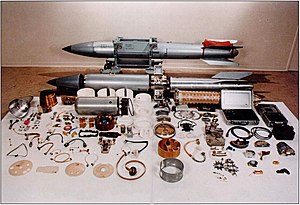This article includes a list of references, related reading, or external links, but its sources remain unclear because it lacks inline citations. Please help improve this article by introducing more precise citations. (February 2014) (Learn how and when to remove this message)

A warhead is the section of a device that contains the explosive agent or toxic (biological, chemical, or nuclear) material that is delivered by a missile, rocket, torpedo, or bomb.
Classification
[edit]Types of warheads include:
- Explosive: An explosive charge is used to disintegrate the target, and damage surrounding areas with a blast wave.
- Conventional: Chemicals such as gunpowder and high explosives store significant energy within their molecular bonds. This energy can be released quickly by a trigger, such as an electric spark. Thermobaric weapons enhance the blast effect by utilizing the surrounding atmosphere in their explosive reactions.
- Blast: A strong shock wave is provided by the detonation of the explosive.
- Fragmentation: Metal fragments are projected at high velocity to cause damage or injury.
- Continuous rod: Metal bars welded on their ends form a compact cylinder of interconnected rods, which is violently expanded into a contiguous zig-zag-shaped ring by an explosive detonation. The rapidly expanding ring produces a planar cutting effect that is devastating against military aircraft, which may be designed to be resistant to shrapnel.
- Shaped charge: The effect of the explosive charge is focused onto a specially shaped metal liner to project a hypervelocity jet of metal, to perforate heavy armour.
- Explosively formed penetrator: Instead of turning a thin metal liner into a focused jet, the detonation wave is directed against a concave metal plate at the front of the warhead, propelling it at high velocity while simultaneously deforming it into a projectile.
- Nuclear: A runaway nuclear fission (fission bomb) or nuclear fusion (Thermonuclear weapon) reaction causes immense energy release.
- Conventional: Chemicals such as gunpowder and high explosives store significant energy within their molecular bonds. This energy can be released quickly by a trigger, such as an electric spark. Thermobaric weapons enhance the blast effect by utilizing the surrounding atmosphere in their explosive reactions.
- Chemical: A toxic chemical, such as poison gas or nerve gas, is dispersed, which is designed to injure or kill human beings.
- Biological: An infectious agent, such as anthrax spores, is dispersed, which is designed to sicken or kill humans.
Often, a biological or chemical warhead will use an explosive charge for rapid dispersal.
Detonators
[edit]Explosive warheads contain detonators to trigger the explosion.
Types of detonators include:
| Type | Definition |
|---|---|
| Contact | When the warhead makes physical contact with the target, the explosive is detonated. Sometimes combined with a delay, to detonate a specific amount of time after contact. |
| Proximity | Using radar, sonar, a magnetic sensor, or a laser, the warhead is detonated when the target is within a specified distance. It is often coupled with directional explosion control system that ensures that the explosion sends the fragmentation primarily towards the target that triggered it. |
| Timed | Warhead is detonated after a specific amount of time. |
| Altitude | Warhead is detonated once it falls to a specified altitude, usually in an air burst. |
| Remote | Remotely detonated via signal from operator. (Not normally used for warheads except for self-destruction) |
| Combined | Any combination of the above. |
See also
[edit]References
[edit]Wikimedia Commons has media related to Warheads.
- "The B61 (Mk-61) Bomb". The Nuclear Weapon Archive. 9 January 2007. Archived from the original on Nov 30, 2023.
- "B61". GlobalSecurity.org. April 16, 2017. Archived from the original on Mar 16, 2023.
- "B61 Nuclear Gravity Bomb". Brookings Institution. Archived from the original on Mar 10, 2012.
- Stephen I. Schwartz. "Atomic Audit - The Costs and Consequences of U.S. Nuclear Weapons Since 1940". Brookings Institution Press, 1998.
- "B61 Thermonuclear Bomb". Hill Air Force Base. 2008. Archived from the original on May 25, 2011.
- "NNSA Achieves Significant Milestone for B61 Bomb". NNSA. June 30, 2006. Archived from the original on Jul 30, 2009.
- Chuck Hansen, U.S. Nuclear Weapons: The Secret History, (New York: Orion Books, 1988), pp. 162–164.